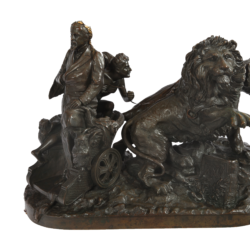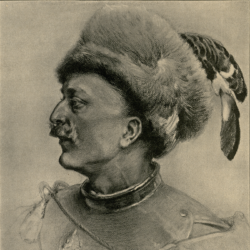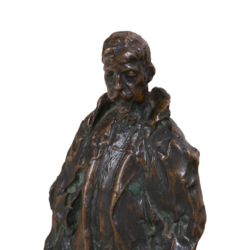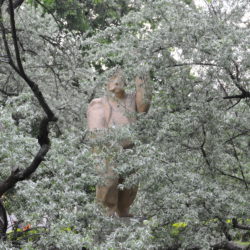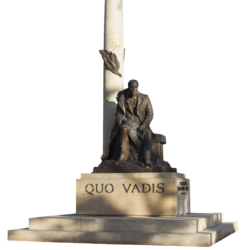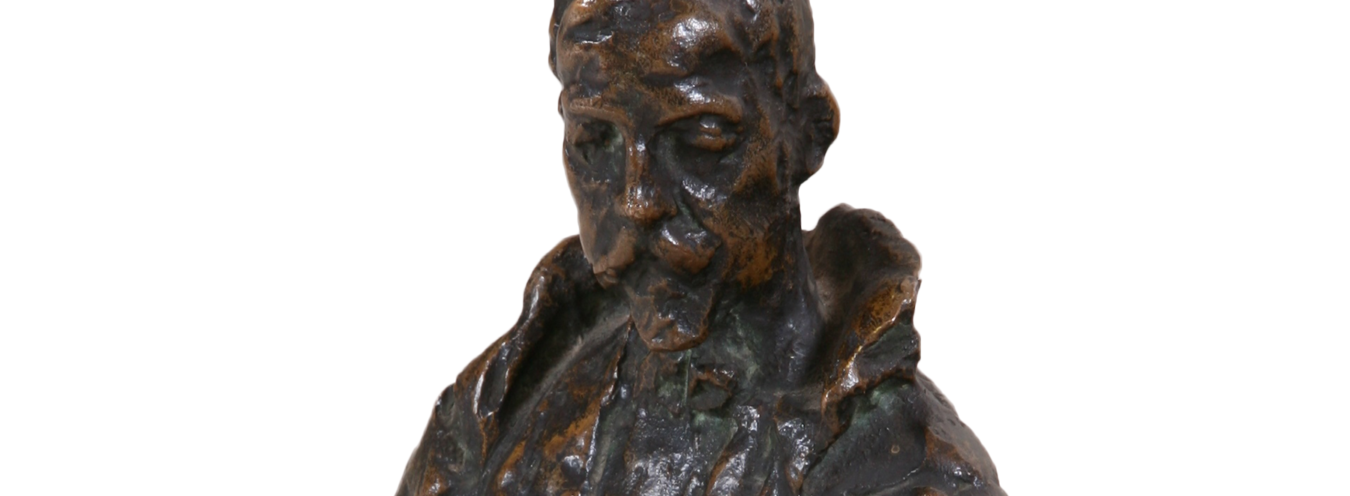
Sienkiewicz’s monuments in the interwar period
The construction of Sienkiewicz monuments and memorial plaques exemplifies the writer’s paradoxical presence in the popular consciousness of 20th-century Poland. Their chronology may seem puzzling at first, not the least so as the earliest Sienkiewicz bust in the public space was financed by the First Polish Sea Bathing Association of Gdynia in 1924, when Gdynia itself, not yet granted its municipal rights, was still more of an urban design project than a city.[1] The earliest statue was sculpted by Konstanty Laszczka and unveiled in Bydgoszcz in 1927. Demolished by German occupiers in 1939, it was reconstructed on the original site in 1968.[2] A similar fate befell a pillared bust in Sompolno in the southern Kuyavia region (though its reconstruction had to wait for an initiative of a local teacher and activist in the mid-1980s).[3] The pre-war monuments in Zbarazh and Kamianets-Podilskyi, in turn, were irretrievably lost.[4] In 1934, the 700th anniversary of the town of Łuków was marked with the unveiling of an obelisk to the “Son of Podlasie” (which is how Sienkiewicz was referred to in pre-war source literature).[5] The most spectacular memorial to Sienkiewicz in the pre-WWII years was probably the Mound in Okrzeja, situated close to his birthplace – the village of Wola Okrzejska. Building a mound was both expense- and time-consuming, which is why a number of such initiatives in the interwar period came to nothing or continued for years without much success (e.g., the Mound of Freedom in Poznań[6]). Even the intention to bring the writer’s remains back to Poland, first voiced in 1924 by Henryk Przeździecki, Bishop of Siedlce, took more than ten years to complete. Despite the Polish society’s considerable enthusiasm and eagerness to unite in common efforts to erect the mound, most of the work was actually carried out by “hired hands”[7] and financed from a variety of sources, such as donation postcards, contributions from Polish immigrant community in the United States, etc. It is important to note that, while most of the previously-mentioned initiatives were local (apart from the writer’s home town of Łuków) and usually accomplished in the Western regions (cities of Bydgoszcz, Gdynia) and Eastern Borderlands (Kamianets-Podilskyi, Zbarazh), the completion of Sienkiewicz Mound in Okrzeja can be attributed solely to the fact that it was an all-Polish project. The Mound was officially opened to the public on October 2, 1938. However, since there was neither time nor money to fulfill the original design, the top was adorned not with a monument, but with a simple field stone engraved with a commemorative inscription. It was only forty years later, in the early autumn of 1980, that the public could attend the unveiling of the writer’s white marble portrait by Marian Gardziński (Siedlce’s own painter and sculptor, a former student of Franciszek Strynkiewicz).[8]
The specific forms of the monuments and ideological settings of their unveiling ceremonies also carried a meaning of their own. Jan Kochanowski Park in the center of Bydgoszcz saw the installation of a realistic bronze statue of Sienkiewicz with one hand on the chronicle of Poland, guarded by two eagles – the symbol of the Piasts, the first Polish ruling dynasty.[9] The unveiling was attended by Michał Drzymała, whose ingenious opposition to the Prussian occupiers had made him a folk hero. On the same occasion, composer Feliks Nowowiejski conducted an orchestral performance of his musical arrangement for the Polish unofficial anthem, Rota (The Oath). As emphasized by its originators, the monument was supposed to unite Bydgoszcz residents, who hailed from different parts of Poland and represented many different generations.[10] The same objective, only on a wider, national scale, governed the Okrzeja Mound project, its design being equally lucid and conventional. In Łuków, the context was distinctly different as the monument was erected in the then outskirts of the town, and the opening ceremony was accompanied by a sports festival. The main contrast, though, was the commemoration’s formal dimension: Łuków gained an obelisk “modern in style, linear in shape, simple, seven-meter high, made of reinforced concrete and covered with terrazzo tiles.”[11] The author of these words, Cezary Cybulski (just like Przeworska quoted by him in the article), is clearly not fond of the obelisk since he states that “one certainly needs time to get used to the style, or rather the artistic mannerism of today” and that “the structure exudes no charm of pure-white alabaster or raven-black marble.” Only the originality of form that Cybulski (rather exaggeratedly) associates with Cubism is said to be of any value.[12] Perhaps this longing for figurative art has persisted long enough to result in not just one, but two naturalistic representations unveiled in Łuków in recent years.
Przypisy
- The date was not conicendental: 1924 saw the return of the writer’s remains to Poland. The bronze bust was installed in Kamienna Góra’s garden square, later named after Sienkiewicz. During WWII, German occupiers were going to melt the bust, but it survived the war to be returned to its original site (a small roundabout at the junction of Korzeniowski, Mickiewicz, and Sienkiewicz Streets (see Encyklopedia Gdyni [The encyclopedia of Gdynia], edited by M. Sokołowska, I. Greczanik-Filipp, W. Kwiatkowska, Gdynia 2006, p. 612).
- The pre-war story of the monument is recounted by J. Konieczny in “Kult pośmiertny Henryka Sienkiewicza w XX-leciu międzywojennym. O dziejach pierwszego w Polsce pomnika pisarza w Bydgoszczy” [Henryk Sienkiewicz’s posthumous cult in the 1920s and 1930s: On the writer’s first monument in Bydgoszcz], in Henryk Sienkiewicz. Biografia, twórczość, recepcja [Henryk Sienkiewicz: Biography, works, reception], edited by L. Ludorowski, H. Ludorowska, Lublin 1998, pp. 349–360.
- L. Ludorowski, “Z Sienkiewiczem w Europie” [In Europe with Sienkiewicz], in Henryk Sienkiewicz. Polak i Europejczyk [Henryk Sienkiewicz: Polish and European], edited by Z. Mokranowska, Sosnowiec 2004, pp. 20–21; http://www.zspsompolno.internetdsl.pl/html/historia.html, accessed on September 10, 2017.
- L. Ludorowski, op. cit., p. 21.
- C. Cybulski, “Historia pomnika Henryka Sienkiewicza w Łukowie” [The history of Henryk Sienkiewicz’s monument in Łuków], in Sienkiewicz – pamięć i współczesność [Henryk Sienkiewicz: Memory and modernity], edited by L. Ludorowski, H. Ludorowska, Z. Mokranowska, Lublin 2003, p. 269.
- M. J. Januszkiewicz, A. Pleskaczyński, I haj vivat Poznzańczanie. Co o Poznaniu wiedzieć wypada [What you should know about Poznań], Poznań 2001, pp. 114–115.
- S. Anioła, J. Bogucki, M. Formanowski, Kopiec Wolności w Poznaniu jako symbol niepodległości [The Mound of Freedom in Poznań as a symbol of independence], Poznań 1992, pp. 42–43.
- For more details, see A. Cybulski, “Historia budowy pomnika-kopca Henryka Sienkiewicza” [The history of Henryk Sienkiewicz Mound-Monument], in Henryk Sienkiewicz – tradycje rodowe, epizody biografii, twórczość [Henryk Sienkiewicz: Family traditions, biographical episodes, works], edited by L. Ludorowski, Lublin 2008, pp. 515–521.
- J. Konieczny, op. cit., p. 351.
- Ibidem, pp. 351, 360.
- C. Cybulski, op. cit., p. 271; trans. J. M.
- Ibidem, pp. 273–274.

